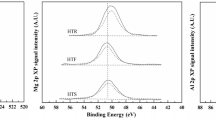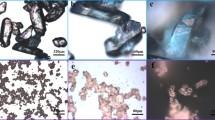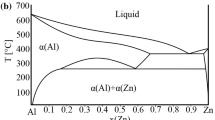Abstract
A complex of Lutetium perchloric acid coordinated with l-glutaminic acid (C5H9NO4) and imidazole (C3H4N2), Lu(C5H9NO4)(C3H4N2)6(ClO4)3·5HClO4·10H2O was synthesized and characterized. Thermodynamic properties of the complex were studied with an adiabatic calorimeter (AC) from 80 to 390 K and differential scanning calorimetry (DSC) from 100 to 300 K. Two thermal abnormalities were discovered at 220.34 and 248.47 K, which were deduced to be phase transitions. One was interpreted as a freezing-in phenomenon of the reorientational motion of ClO4 − ions and the other was attributed to the orientational order/disorder process of ClO4 − ions. The low-temperature molar heat capacities were measured by AC and the thermodynamic functions [H T − H 298.15] and [S T − S 298.15] were derived in the temperature range from 80 to 390 K with temperature interval of 5 K. Thermal decomposition behavior of the complex was studied by thermogravimetric analysis and DSC.




Similar content being viewed by others
References
Anghileri LJ. On the antitumor activity of gallium and lanthanides. Arzneim Forsch. 1975;25:793–5.
McCarthy GJ. Rare earths in modern science and technology. New York: Plenum Press; 1980. p. 25–105.
Sudhindra NM, Joshi GK, Bhutra MP. Syntheses and absorption spectral studies of praseodymium (III) and neodymium (III) complexes with amino acids. Indian J Chem. 1982;21A:275–8.
Xu H, Chen L. Study on the complex site of l-tyrosine with rare-earth element Eu3+. Spectrochim Acta Part A. 2003;59:657–62.
Zhang H, Feng J, Zhu W-f. Rare-earth element distribution characteristics of biological chains in rare-earth element-high background regions and their implications. Biol Trace Elem Res. 2000;73:19–27.
Glowiak T, Legendziewicz J, Huskowska E, Gawryszewska P. Ligand chirality effect on the structure and its spectroscopic consequences in [Ln2(Ala)4(H2O)8](ClO4)6. Polyhedron. 1996;15:2939–47.
Liu B-P, Lv X-C, Tan Z-C, Zhang Z-H, Shi Q, Yang L-N, Xing J, Sun L-X, Zhang T. Molar heat capacity and thermodynamic properties of crystalline Ho(Asp)Cl2·6H2O. J Therm Anal Calorim. 2007;89:283–7.
Liu B-P, Tan Z-C, Xu F, Yu P, Xing J. Low-temperature heat capacity and thermodynamic properties of crystalline [RE (Gly)3(H2O)2]Cl3·2H2O (RE = Pr, Nd, Gly = Glycine). Thermochim Acta. 2003;397:67–73.
Lv X-C, Liu B-P, Tan Z-C, Zhang Z-H, Shi Q. Sun X-l, molar heat capacity and thermodynamic properties of [Er(Pro)2(H2O)5Cl2] crystalline. J Chem Eng Data. 2006;51:1526–9.
Lv X-C, Tan Z-C, Gao X-H. Thermodynamic properties and molar heat capacity of Er2(Asp)2(Im)8(ClO4)6·10H2O. J Therm Anal Calorim. 2011;103:1119–24.
Lv X-C, Tan Z-C, Gao X-H. Molar heat capacities, thermodynamic properties, and thermal stability of Lu(C2H5O2N)2Cl3·3H2O. J Chem Eng Data. 2011;56:1383–7.
Nakamoto K. Infrared spectra of inorganic and coordination compounds. 4th ed. New York: Wiley; 1986. p. 258.
Wayda AL, Kaplan ML. Mixed ligand imidazole complexes of organo-lanthanides. Polyhedron. 1990;9:751–6.
Tan Z-C, Liu B-P, Yan J-b, Sun L-X. A fully automated adiabatic calorimeter workable between 80 and 400 K. Comput Appl Chem. 2003;20:264–268 (in Chinese).
Zeng J-l, Yu S-b, Tong B, Sun L-X, Tan Z-C. Heat capacities and thermodynamic properties of (S)-tert-butyl 1-phenylethylcarbamate. J Therm Anal Calorim. 2011;103(3):1087–93.
Wu J, Chen S-P, Gao S-l. Low-temperature thermodynamics of Ln(Me2dtc)3(C12H8N2) (Me2dtc = dimethyldithiocarbamate, Ln = La, Pr, Nd, Sm). J Therm Anal Calorim. 2010;100:1091–8.
Lv X-C, Gao X-H, Tan Z-C. Molar heat capacity and thermodynamic properties of 1,2-cyclohexane dicarboxylic anhydride [C8H10O3]. J Therm Anal Calorim. 2008;92:523–7.
Zhao Z-M, Sun L-X, Tan Z-C. Heat capacities and thermodynamic properties of N-(tert-butoxycarbonyl)-l-phenylalanine (C14H19NO4). J Therm Anal Calorim. 2011;3 (online first).
Donald GA. Thermodynamic properties of synthetic sapphire standard reference material 720 and the effect of temperature- scale difference on thermodynamic properties. J Phys Chem Ref Data. 1993;22:1441–52.
Yukawa Y, Igarashi S, Masuda Y, Oguni M. Phase transition and glass transition concerning configurational order/disorder of ions in crystalline (TMA)2[Sr{Ni(pro)2–6](ClO4)4 and (TMA)[Sm{Ni(pro)2–6](ClO4)4. J Mol Struct. 2002;605:277–90.
Anna, MM, Edward M, Hetmańczyk Ł, Natkaniec I, Ściesińska E, Ściesiński J, Wróbel S. Phase transition, molecular motions, structural changes and low- frequency vibrations in [Cu(NH3)5](ClO4)2. Chem Phys. 2005;317:188–197.
Hangam SS, Westrumj ER. Heat capacities and thermodynamic properties of globular molecules. I. adamantane and hexamethylenetetramine. Thermodynamic properties of globular. Molecules. 1960;64:1547–51.
Udowenko AA, Laptash NM, Maslennikova IG. Orientation disorder in ammonium elpasolites crystal structures of (NH4)3AlF6,(NH4)3TiOF5 and (NH4)3FeF6. J Fluor Chem. 2003;124:5–15.
Acknowledgements
This study was financially supported by the National Nature Science Foundation of China under the Grant NSFC NO. 21103078, 21003069, 21073189.
Author information
Authors and Affiliations
Corresponding author
Rights and permissions
About this article
Cite this article
Lv, XC., Tan, ZC., Gao, XH. et al. Molar heat capacity and thermodynamic properties of Lu(C5H9NO4)(C3H4N2)6(ClO4)3·5HClO4·10H2O. J Therm Anal Calorim 111, 971–976 (2013). https://doi.org/10.1007/s10973-012-2204-y
Received:
Accepted:
Published:
Issue Date:
DOI: https://doi.org/10.1007/s10973-012-2204-y




